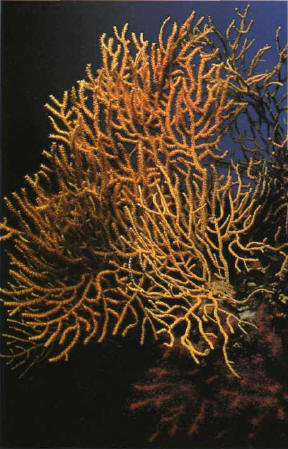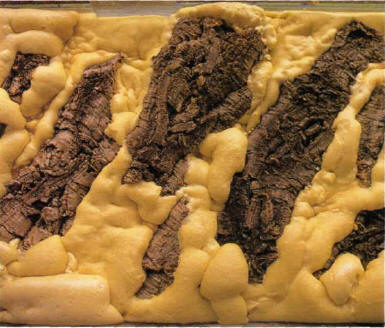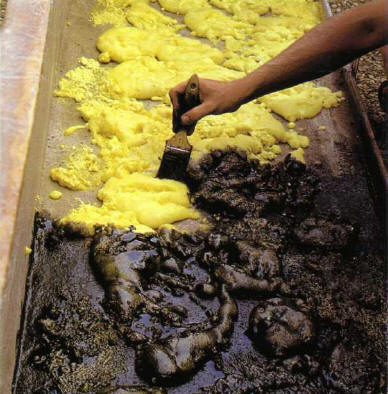ARTIFICIAL DECOR
Modern artificial products are rapidly growing in popularity, especially in large
freshwater and marine aquariums. Their main advantage is the creative freedom they
give to a fishkeeper, making it possible to choose decor that fits his or her exact
requirements.
Two main types of material are used: polystyrene and polyurethane. They are both
light and neutral.

Gorgons have a dark skeleton that makes an attractive decorative
element.
Polystyrene
Available in blocks or sheets, it is usually used as a protection against bumps
and heat (in some household electrical appliances, for example). You can recycle
it or buy it in a store.
Small-grained polystyrene is preferable as it is stiffen It is very light and
floats on water, so it must therefore be fixed into the aquarium. Polystyrene can
be prepared to meet your requirements before putting it into the tank.

Decor made of polystyrene sheets: the entire sheet can be
placed vertically against the back of the aquarium.
Polystyrene decor
Use a serrated knife or small saw to cut the cold blocks or sheets, or you can
work with heated polystyrene, with a portable blowtorch or hot-air paint stripper.
Be careful when handling polystyrene as it can melt, catch fire, and emit toxic
vapors.
The diagram on the following page explains how to make this type of decor. Cut
a block in the size and shape you need. If you are using sheets a few centimeters
thick, you can heighten the relief by putting several sheets on top of each other.
These are stuck together using resin mixed with sand. The design shown can be completed
with other pieces of polystyrene, which can partially mask the side panes.
You can also combine sheets with large or small blocks. Then burn the parts that
are visible to give them a natural look. At this point natural elements such as
rocks or coral skeletons can be added, and resin and sand are applied to the structure
(apart from the natural elements), before clearing up with a vacuum cleaner. This
whole process is usually completed outside the aquarium, as it is more practical,
and the decor is then stuck to the glass panes with silicone glue.
Polyurethane Polyurethane foam can be made from two components mixed together,
but it is also available in aerosols that are more practical. The product released
rapidly increases in volume and solidifies in a few minutes. It can then be sculpted
with sharp instruments.
Polyurethane decor
Before taking the plunge into the construction of polyurethane decor, it is advisable
to watch somebody else perform the same operation first, to avoid making mistakes.
In this case the decor must be created inside the aquarium. If you have made
the tank yourself, it is also more practical to put the decor in place before adding
the front glass pane, as this makes the process a lot easier.
The aquarium needs minor preparations beforehand to receive the polyurethane:
- stick small offcuts of glass, at intervals of a few centimeters, in the
places that will hold the decor;
- another option is to make a mixture of sand and silicone glue and deposit
this mixture at regular intervals in the areas to be decorated.
Then pour on the polyurethane in small doses. You can work vertically to create
a decor resembling a cliff; it is also possible to incorporate rocks, pieces of
dead coral, or cavities for plants. In tanks equipped with a box filter, do not
forget the passageways for the water coming in and going out; these can be molded
on plastic pipes. The polyurethane dries very quickly and can be sculpted with a
knife or small saw, to give it a finish that is more natural than its original smooth
surface. Finally, use a vacuum cleaner to remove the offcuts.

Polyurethane is increasingly used for decorating large tanks.
Here it is combined with cork bark.
Terracotta
Terracotta decors, made from clay to imitate the form of rocks, are commercially
available from specialist suppliers.
Although some hobbyists make their own terracotta decor, polystyrene and polyurethane
are more common, largely as a result of aquarium clubs and associations that offer
guidance to beginners in these techniques.
Making a terracotta decor
Contact a tile or flowerpot factory to obtain the raw material and to get it
fired. Use clay, which is neutral and malleable. For a medium-sized decor, calculate
around 100 g of clay per liter of volume, but only practice or the advice of more
experienced aquarists will offer you more precise indications.
Model the clay in accordance with the decor you want:
- rocks of varying sizes;
- rocky cliff or slope;
- grottoes, arches.
The end results should have a natural look. All the elements must be dried in
the open air and then fired in an oven at 800-900°C. This reduces their weight by
25-30% and endows them with a color resembling tiles. A final option is the application
of resin and sand on the surfaces of the decor.
Resin

Resin applied to polyurethane can be dyed with food colorings,
in this case a mixture of red and black.
This allows you to polish the decor. It is possible just to use artificial decor
without treating it and wait until it acquires a patina after being in the tank
for a few months. However, most hobbyists prefer to give it a natural appearance
by incorporating a range of materials: sediments of varying textures, such as sand,
gravel, coralline sand, or pieces of rock or coral. To make these adjustments, a
so-called food resin, epoxy resin, is used, as it has no influence on the water.
It is made up of two components which harden when they are mixed together, and it
can be colored to look more natural.
|